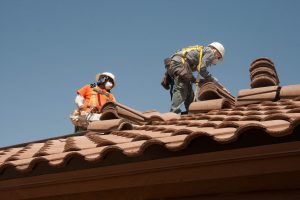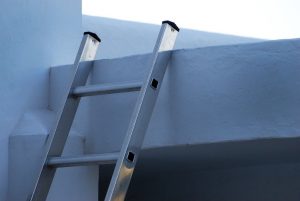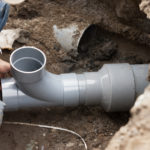Roof workers are vulnerable to a host of safety concerns when they perform roofing responsibilities high on a commercial roof. The Occupational Safety and Health Administration (OSHA) is a part of the United States Department of Labor, which sets clear guidelines and rules to help protect employees, like roof workers.
OSHA offers a level of protection to aid roofers from work-related falls, injuries and death. The following are precautions employers and roofers must heed to ensure their careers are long and safe.
OSHA Safety Standards for Commercial Roofers

Personal fall protection equipment is an OSHA standard and a required safety measurement for all roofing workers. OSHA’s rule on Walking-Working Surfaces and Personal Fall Protection Systems estimates that it prevents 29 deaths resulting from roofing work as well as 5,842 lost workdays due to severe work-related injuries. This government guideline addresses hazards such as trips, falls, and slips.
Roofing employers are required by OSHA to provide fall protection systems to employees. Employers have the benefit and flexibility of choosing from a wide variety of fall protection systems. Instead of scaffolding, for instance, employers might choose from other diverse forms of fall protection.
In 2017, OSHA released updated guidelines to protect roofing workers from occupational hazards, including the following:
- Workers are to be trained in fall hazards and in the use of equipment.
- Ladder safety systems are to be implemented on fixed ladders over 24 feet.
- Fixed ladders over 24 feet are to be equipped with a cage or other ladder safety mechanism, such as a personal fall arrest system.
OSHA acknowledges that roofers who perform their duties at heights of at least six feet are at risk for serious injuries or death if they fall. Fortunately, safety measurements are available to help curtail any hazards.
Fall Protection Training

Fall protection training is the first line of defense for roofers working on commercial buildings. Employers are responsible for providing this education to its employees who are at risk. Included in the training is information about how to recognize when dangers of falling are existent and how to minimize the risk. Plus training must be provided to help roofers learn how to erect and disassemble fall protection equipment, inspect it and maintain it.
Personal Fall Arrest System
A personal fall arrest system (PFAS) is required by roofing employers to minimize occupational risks. The PFAS feature anchors, harnesses and a lifeline (or lanyard) to prevent roofing workers from on-the-job falls. PFAS should be designed to prevent falls from heights of six feet or greater, according to OSHA. Fall arrest systems should be able to hold 5,000 pounds per roofer and must never be anchored to sheathing or guardrails—which are too weak to meet OSHA safety standards.
Fall Restraint System
OSHA also outlines the use of a fall restraint system to protect roofing workers from potential falls. Typically, fall restraint systems offer safety by blocking the edge of the roof if the roofer loses his footing and slides down the roof.
Guardrails
Guardrails are positioned around a roof’s perimeter to aid in fall protection. Temporary guardrails are attached to the rafters or similar structures. Guardrails should be sturdy enough to withstand 200 pounds of force. Mesh, screens and solid panels should be well-constructed to withstand 150 pounds of force in a downward or outward direction.
Warning Lines

Warning lines, consisting of wires, chains or rope, are also used in commercial roofing projects to protect roofers. OSHA indicates that warning lines should have minimum flexible strength of 500 pounds for maximum efficacy.
Covers
Commercial roofs feature skylights and similar openings through which workers may fall. OSHA indicates that covers can be used to prevent workers from falling through such holes in rooftops. Covers must be securely installed so as to avoid being displacement by wind gusts, other employees or equipment.
Ladder Safety
Ladders are used to access commercial rooftops. The two common types of ladders utilized in roofing projects are extension ladders and stepladders. Given the importance of this equipment, employers must ensure all ladders are regularly inspected for visible flaws.
To maximize safety, all roofers must be trained in how to properly use equipment, including ladders. Ladders must be positioned on stable and even surfaces. Employers should train roofers to maintain three points of contact—two hands and one foot, for example—at all times when on the ladder.
Any tools a roofer needs must be hoisted up in a bucket and never carried up the ladder. Carrying tools while ascending or descending the ladder can cause roofers to lose their balance.
Scaffolding Precautions
Scaffolding can be dangerous for roofers, who are vulnerable to falling while climbing onto or off of a scaffold. Employers are required by OSHA to offer safe access to scaffolds. Stair towers, portable ladders, and ramps are all examples that employers can utilize to ensure safety. Guardrails also provide safety when the scaffold is ten feet or more above ground.
Professional Commercial Roofers

Commercial roofing work is performed on the rooftops of schools, restaurants, offices, warehouses and churches, among other similar building structures. When your commercial roof requires maintenance, contact the most trusted roofing company in the Lake Zurich, IL area, Reliable Roofing, to provide a practical solution.
Reliable Roofing offers a multitude of services, including roof maintenance, commercial roof replacement, roof repair, roof installation, the construction or rebuilding of rooftops and the repair, building, and maintenance of the increasingly popular sheet metal roofing.
Following OSHA Safety Requirements
The roofers at Reliable Roofing always use best practices and materials when working on rooftops to ensure clients receive optimum results. The company is also licensed, insured and bonded, offering customers peace of mind while roofers work. Reliable Roofing is a member of the National Roofing Contractors Association.
Shield your commercial roof from damage and simultaneously protect the people who work under it, the goods the building houses, your property and any assets by contacting Reliable Roofing when your roof requires attention.
Commercial roof damage can lead to costly repairs unless addressed right away. Reliable Roofing understands the urgency a roofing project may require, so the team swiftly responds to calls within 24 hours.


